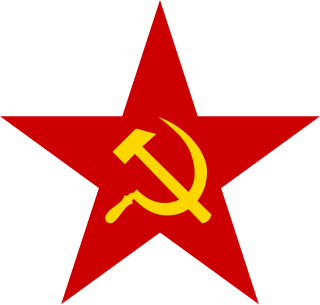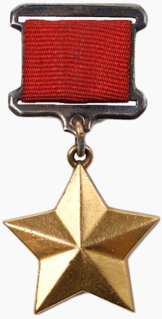
The Order of the Red Star was a military decoration of the Soviet Union. It was established by decree of the Presidium of the Supreme Soviet of the USSR of 6 April 1930 but its statute was only defined in decree of the Presidium of the Supreme Soviet of the USSR of 5 May 1930. That statute was amended by decrees of the Presidium of the Supreme Soviet of the USSR of 7 May 1936, of 19 June 1943, of 26 February 1946, of 15 October 1947, of 16 December 1947 and by decree No 1803-X of 28 March 1980.

The Medal "In Commemoration of the 800th Anniversary of Moscow" was a state commemorative medal of the Soviet Union established by decree of the Presidium of the Supreme Soviet of the USSR on September 20, 1947 and bestowed to prominent Soviet citizens and veterans in commemoration of the 800th anniversary of the first Russian reference to Moscow, dating to 1147 when Yuri Dolgorukiy called upon the prince of the Novgorod-Severski to "come to me, brother, to Moscow". Its statute was amended by decree of the Presidium of the Supreme Soviet of the USSR on July 17, 1980.

The Medal "In Commemoration of the 1000th Anniversary of Kazan" is a state commemorative medal of the Russian Federation established on June 30, 2005 by Presidential Decree № 762 to denote the 1000th anniversary of the foundation of Kazan, the capital city of Tatarstan.

The Medal "In Commemoration of the 300th Anniversary of Saint Petersburg" is a state commemorative medal of the Russian Federation established on February 19, 2003 by Presidential Decree № 210 to denote the 300th anniversary of the foundation of the city of St Petersburg, known as Leningrad during the Soviet Era.

The Jubilee Medal "Thirty Years of Victory in the Great Patriotic War 1941–1945" was a state commemorative medal of the Soviet Union established on April 25, 1975 by decree of the Presidium of the Supreme Soviet of the USSR to denote the thirtieth anniversary of the Soviet victory over Nazi Germany in World War II.

The Jubilee Medal "30 Years of the Soviet Army and Navy" was a state military commemorative medal of the Soviet Union established on February 22, 1948 by decree of the Presidium of the Supreme Soviet of the USSR to denote the thirtieth anniversary of the creation of the Soviet Armed Forces. Its statute was later amended by decree of the Presidium of the Supreme Soviet of the USSR of July 18, 1980.

The Jubilee Medal "40 Years of the Armed Forces of the USSR" was a state military commemorative medal of the Soviet Union established on December 18, 1957 by decree of the Presidium of the Supreme Soviet of the USSR to denote the fortieth anniversary of the creation of the Soviet Armed Forces. Its statute was later amended by decree of the Presidium of the Supreme Soviet of the USSR of July 18, 1980.

The Jubilee Medal "50 Years of the Armed Forces of the USSR" was a state military commemorative medal of the Soviet Union established on December 26, 1967 by decree of the Presidium of the Supreme Soviet of the USSR to denote the fiftieth anniversary of the creation of the Soviet Armed Forces. Its statute was amended on three separate occasions, by decrees of the Presidium of the Supreme Soviet of the USSR of February 22, 1968., of December 19, 1969, and of July 18, 1980.

The Jubilee Medal "60 Years of the Armed Forces of the USSR" was a state military commemorative medal of the Soviet Union established and bestowed to military personnel to denote the sixtieth anniversary of the creation of the armed forces of the Soviet Union. It was established on January 28, 1978 by decree of the Presidium of the Supreme Soviet of the USSR. Its statute was amended by decree of the Presidium of the Supreme Soviet of the USSR on July 18, 1980.

The Jubilee Medal "70 Years of the Armed Forces of the USSR" was a state military commemorative medal of the Soviet Union established on January 28, 1988 by decree of the Presidium of the Supreme Soviet of the USSR to denote the seventieth anniversary of the creation of the Soviet Armed Forces.
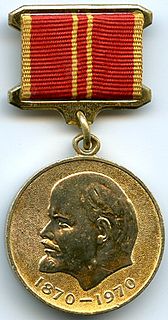
The Jubilee Medal "In Commemoration of the 100th Anniversary of the Birth of Vladimir Ilyich Lenin" was a state commemorative medal of the Soviet Union established by decree of the Presidium of the Supreme Soviet on November 5, 1969 to commemorate the 100th anniversary of the birth of Vladimir Lenin. Its statute was amended on July 18, 1980 by decree of the Presidium of the Supreme Soviet. It was awarded to eminent members of Soviet society, the military leadership and foreign members of the international communist and labour movements.

The Medal "For the Defence of Odessa" was a World War II campaign medal of the Soviet Union established on December 22, 1942 by decree of the Presidium of the Supreme Soviet of the USSR to reward the participants of the defence of the port city of Odessa from the armed forces of NAZI Germany. The medal's statute was amended on July 18, 1980 by decree of the Presidium of the Supreme Soviet of the USSR № 2523-X.

The Medal "For the Defence of Sevastopol" was a World War II campaign medal of the Soviet Union established on December 22, 1942 by decree of the Presidium of the Supreme Soviet of the USSR to reward the participants of the defence of the port city of Sebastapol against the armed forces of Nazi Germany. The medal's statute was amended on July 18, 1980 by decree of the Presidium of the Supreme Soviet of the USSR № 2523-X.
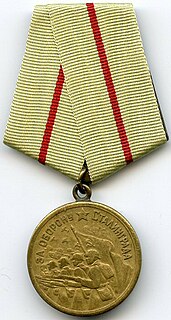
The Medal "For the Defence of Stalingrad" was a World War II campaign medal of the Soviet Union.
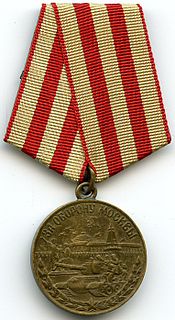
For the Defense of Moscow was a World War II campaign medal of the Soviet Union awarded to military and civilians who had participated in the Battle of Moscow.

The Medal "For the Defence of the Caucasus" was a World War II campaign medal of the Soviet Union.

The Medal "For the Defence of Kiev" was a World War II campaign medal of the Soviet Union established on June 21, 1961 by decree of the Presidium of the Supreme Soviet of the USSR to be awarded to the participants of the defence of the city of Kiev during the 1941 invasion of the USSR by NAZI Germany.

The Medal "For the Capture of Königsberg" was a World War II campaign medal of the Soviet Union established on June 9, 1945 by decree of the Presidium of the Supreme Soviet of the USSR to satisfy the petition of the People's Commissariat for Defense of the Soviet Union for recognition of the participants of the battle to capture the city of Königsberg from the armed forces of Nazi Germany. The medal's statute was amended on July 18, 1980 by decree of the Presidium of the Supreme Soviet of the USSR № 2523-X.

The Medal "For Distinguished Labour" was a civilian labour award of the Soviet Union bestowed to especially deserving workers to recognise and honour high performances in labour or contributions in the fields of science, culture or the manufacturing industry. In just over fifty years of existence, it was bestowed to over two million deserving citizens. It was established on December 27, 1938 by decree of the Presidium of the Supreme Soviet of the USSR. Its statute was amended three times by further decrees, first on June 19, 1943 to amend its description and ribbon, then on December 16, 1947 to amend its regulations, and finally on July 18, 1980 to confirm all previous amendments. The medal ceased to be awarded following the December 1991 dissolution of the Soviet Union.







